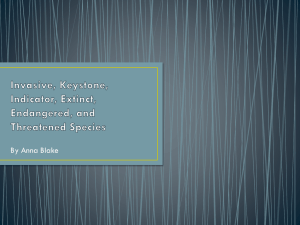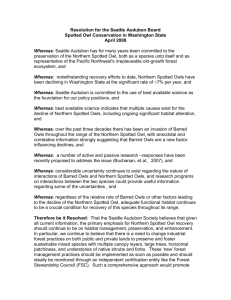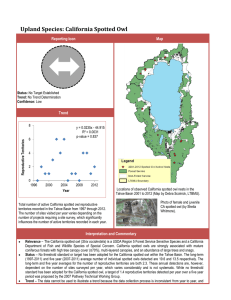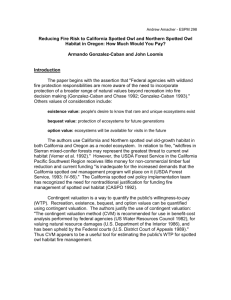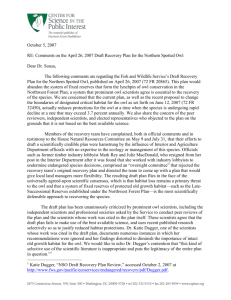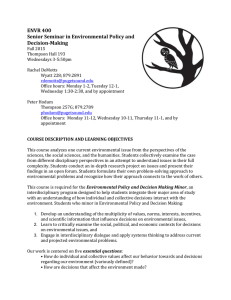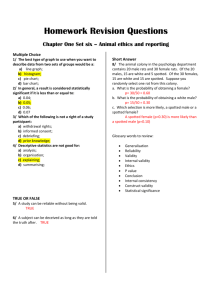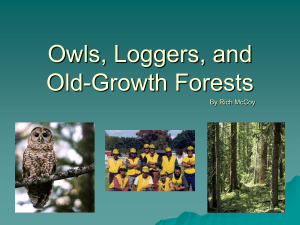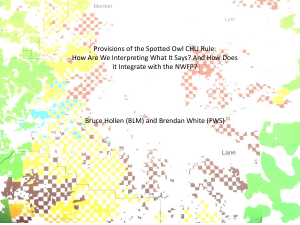endangered species project.jennifer
advertisement
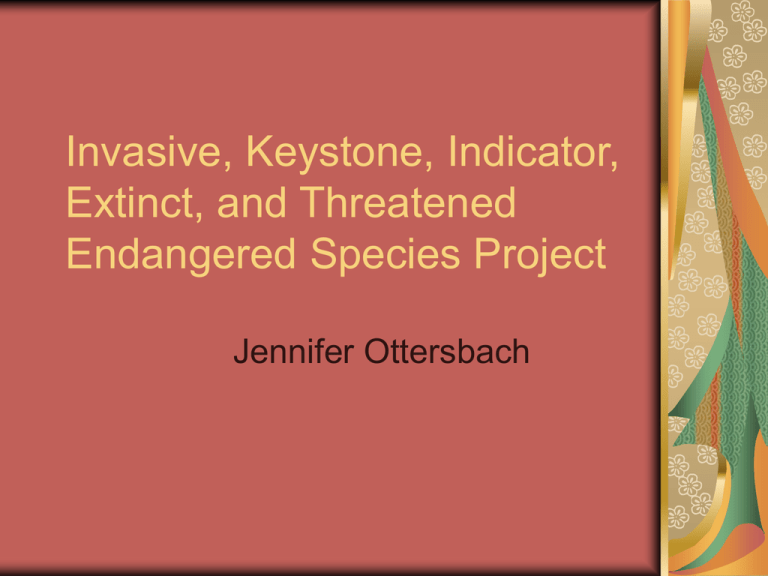
Invasive, Keystone, Indicator, Extinct, and Threatened Endangered Species Project Jennifer Ottersbach Russian Olive Elaeagnus angustifolia native to Eurasia; introduced into the U.S. in the 1800s for ornamental purposes can grow to be 15-30 feet tall and are identifiable by their silverycoated leaves that are usually 1-3 inches long; have yellow flowers that appear in the summer considered invasive because they crowd out native plants Methods for eradicating these plants include cutting them down and removing the cut material as well as the application of herbicides. Golden-rumped Sengi Rhynchocyon chrysopygus is a type of elephant shrew; the size of a small cat; reddish-brown fur with a golden patch on its rump; a long, flexible snout; an insectivore; shares ancestry with elephants, sea cows, hyraxes, aardvark, tenrecs and golden-moles; lives in coastal dense scrub forests and lowland semi-deciduous forests Fossils of elephant shrews first appeared about 50 million years ago; in 1993-1996 population densities decreased by 30%; currently the Arabuko-Sokoke Forest in Kenya is thought to support 10,000-20,000 individuals, with small populations in other fragmented forest patches; listed as an endangered species in 2010 is globally endangered because of habitat loss; its forest habitat has become highly fragmented—remaining areas are thought to be too small to support large populations; known to shelter from predators in hollow trees—but many of the trees favored by the species are being removed by woodcarvers for the tourism industry, which makes them more vulnerable to predators the Arabuko-Sokoke Forest, where most of the species’ population is found, is highly protected; IUCN has produced a Conservation Action Plan for this species which recommends that the conservation strategy should be aimed primarily at protecting the species’ habitat Black-footed Ferret Mustela nigripes have black legs/feet and a distinctive black “mask” marking across their eyes; carnivorous mammals; nocturnal native to the U.S.; were one of the original animals placed on the endangered species list in 1967 and were considered extinct multiple times until small populations of them were found on privately-owned lands; they were nearly wiped out in the late 1900s due to a nationwide effort to get rid of prairie dogs (considered pests); loss of habitat and their susceptibility to plague and canine distemper have also contributed to their decline considered an indicator species because they depend upon prairie dogs for both food and shelter; when a prairie dog population declines, the black-footed ferret population declines the Arizona Game and Fish Department established the first reintroduction program for black-footed ferrets in 1996, after they captured and bred the only 18 living black-footed ferrets found in the wild; they released 35 black-footed ferrets, and are planning a second reintroduction Los Angeles sunflower Helianthus nuttallii parishii Native to California; was once found in San Bernardino, Orange, Riverside and Los Angeles counties; was thought to be extinct since 1937, but one was found in 2002, although the species has become extinct since then produces large yellow blossoms and prefers marshy habitats and boggy riverbanks extinct because of urbanization and the channelization of many Southern California waterways was never really considered in wildlife conservations and restorations of wetlands that had been urbanized Gopher Tortoise Gopherus polyphemus Native to southeast United States; Florida has listed them as a threatened species because they are declining in number throughout their range front legs are shovel-like and equipped with sharp claws for digging; strong back legs to push themselves in and out of burrows; are herbivores and get most, if not all, their water from food; they have a low reproductive rate and do not mature until about 10 years of age are keystone species because they dig burrows that provide shelter for many other types of animals ensure preservation of their habitats, and do not disturb their burrows Northern Spotted Owl Strix occidentalis caurina native to California; historically the owls’ distribution is difficult to determine because early European settlers began cutting the old-growth forests before the owl's range was determined one of three subspecies of spotted owl; live in old-growth forests; dark-to-chestnut brown color with white spots on its head, neck, back and under parts; carnivorous nocturnal hunters threatened because of loss of old growth forest habitat due to logging and deforestation, climate change, and natural disasters; also affected by increasing barred owl populations—they often displace resident spotted owls and sometimes breed with them, creating hybrids has been much controversy over whether the owls should be listed on the Endangered Species List, and so until 1989 there were no plans to conserve the species; in 1989 "A Conservation Strategy for the Northern Spotted Owl" was issued to conserve the habitats of the owls on nearly eight million acres of federal land throughout the owl's range bibliography Russian Olive: http://www.invasivespeciesinfo.gov/plants/russolive.shtml http://na.fs.fed.us/fhp/invasive_plants/weeds/russian-olive.pdf Golden-rumped Sengi: http://www.edgeofexistence.org/mammals/species_info.php?id=46 http://www.watamu.net/foasf.html Black-footed Ferret: http://www.azgfd.gov/w_c/blackfooted_ferret.shtml http://animals.nationalgeographic.com/animals/mammals/black-footed-ferret/ Los Angeles sunflower http://articles.latimes.com/2002/sep/21/local/me-flower21 http://www.thefreelibrary.com/SUNFLOWER+FIND+A+REAL+SURPRISE+PLANT +WAS+LONG-THOUGHT+EXTINCT.-a092253987 Gopher Tortoise http://www.highlandsswcd.org/everything/office%20info/2010%20articles/The%20 Gopher%20Tortoise.pdf http://www.volusia.org/environmental/permitting/tespecies/gtfactsheet.htm Northern Spotted Owl http://www.encyclopedia.com/topic/Northern_spotted_owl.aspx http://www.defenders.org/wildlife_and_habitat/wildlife/spotted_owl,_northern.php
